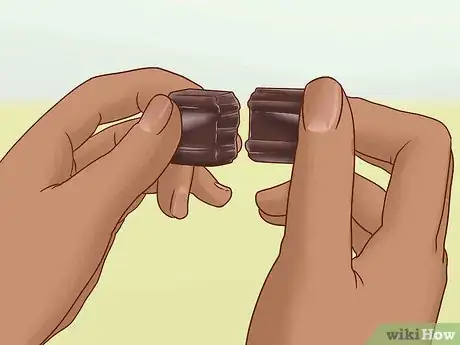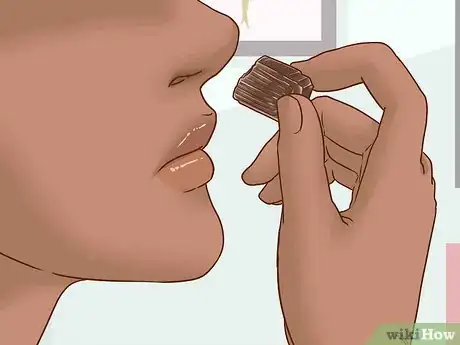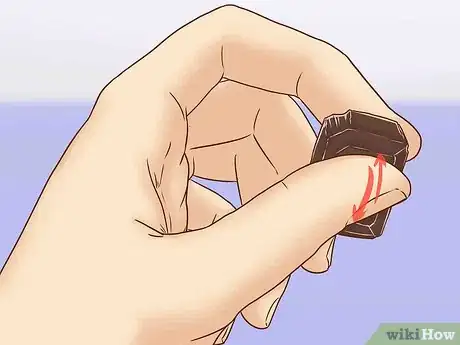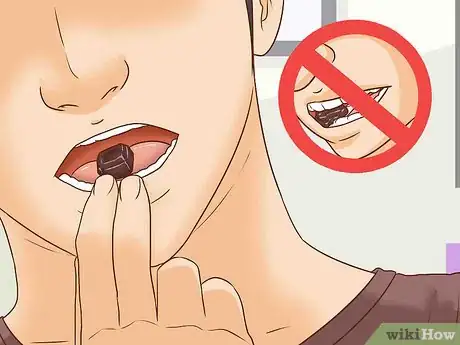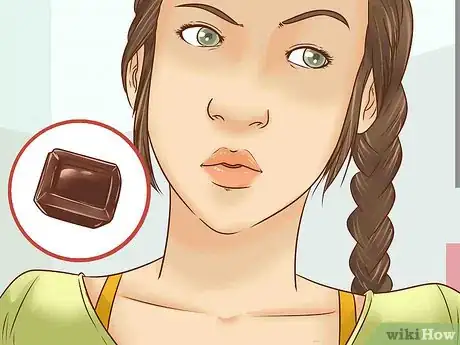This article was co-authored by John Burson. John Burson is a Certified Nutritionist, Licensed Herbalist, and Certified Personal Trainer. With over 25 years of experience, John specializes in helping clients lose weight and live healthier lives. John graduated magna cum laude and received a Bachelor’s degree in Business and Marketing from Grand Canyon University. He has also earned Thumbtack Top Pro honos for three consecutive years.
There are 7 references cited in this article, which can be found at the bottom of the page.
This article has been viewed 403,833 times.
The flavor compounds found in chocolate are complex, varied, and tasty! Dark chocolate in particular has a wide range of flavors, aromas, and textures. Unlike milk chocolate, dark chocolate does not contain milk solids and it has a higher percentage of cocoa. These factors can create a deep, rich, and bitter flavor that varies greatly from chocolate bar to chocolate bar.[1] Learning how to taste dark chocolate and how to find quality dark chocolate will help enhance your tasting experience.
Steps
Using All of Your Senses
-
1Cleanse your palate. Be sure that your mouth is free from residual flavors from a previous meal. This will help you taste the all of the dark chocolate's complex flavors.
- Drink some water, eat an apple or some bread, or chew on a piece of ginger to help cleanse your palate.[2]
-
2Examine the dark chocolate’s surface and color. Quality chocolate should have a smooth, blemish-free, shiny, and even surface. Old chocolate will appear to have a hazy surface, which is referred to as blooming. Observe the color of the chocolate, and make sure the color is even throughout.[3]
- The color of the chocolate is determined by the roasting process of the cacao beans and where the beans originated. Chocolate can have a tint of pink, purple, red, or orange.
Advertisement -
3Break the chocolate in half. Break the chocolate in two and listen for a loud snap. High-quality dark chocolate with higher levels of cocoa will break with smooth edges and create a loud snap. Look for smooth, fine gradients along the broken edges.[4]
-
4Smell the chocolate. Hold the chocolate up to your nose and inhale deeply through your nose. Aroma is an important component of flavor. It helps prep your other senses and enhances the various flavors.
-
5Rub the chocolate. Use one finger to lightly touch the surface of the chocolate. Quality chocolate will have a smooth, even surface that is free from dimples, dents, and other imperfections. The chocolate may melt a bit from your body heat. This will help release some of the aromas and enhance its taste.[5]
-
6Don’t chew the chocolate. Place a sizable piece of chocolate in your mouth, but don’t chew it immediately. Chewing may release some of the bitter flavors that are more common in dark chocolate. Chew it only to break it into small enough pieces that it begins to melt on its own. The cocoa butter in the dark chocolate will melt and will mask any bitter notes.
-
7Pay attention to the chocolate’s texture. As the chocolate melts in your mouth, think about its consistency and how it feels on your tongue. High-quality chocolate will have a velvety texture, while poorer quality chocolate may feel oily, waxy, or grainy.[6]
-
8Concentrate on the chocolate’s flavors. Focus on the flavors of the melting chocolate. Does the chocolate taste similar to the way it smells? Does the taste change over time as it melts and continues to coat your mouth? Notice what flavors are the strongest and what flavors linger the longest.
-
9Write down your thoughts. As you continue to taste more and more dark chocolate, consider writing down your thoughts and observations in a notebook. Be sure to jot down your reflections soon after tasting the chocolate. Keeping a handy record of your tastings will make it easier to reflect on the tastes, textures, and types of dark chocolate you like best!
Finding Quality Dark Chocolate
-
1Buy quality dark chocolate. Visit your local grocer, specialty candy shop, or check out an online vendor to stock up on a selection of dark chocolate. Your local grocery shop may have some popular chocolates in the candy isle. A local specialty candy shop or food market will have a wider selection of dark chocolates to choose from, while an online vendor may provide you with access to excellent chocolate from around the globe.
-
2Look at the list of ingredients. Next time you are searching for a new chocolate bar to try, take a look at the dark chocolate selection and read the labels. Try to choose a dark chocolate that has only a few ingredients on the label.
- Quality dark chocolate should have chocolate liquor or cocoa listed as its first ingredient. Chocolate liquor is the paste that is created while grinding cocoa nibs and it does not contain alcohol.[7]
- You may also see cocoa powder, cocoa nibs, and cocoa butter listed on the label.
- Sugar is usually added to dark chocolate to balance its bitter taste. When choosing dark chocolate, be sure that sugar is not the first ingredient.
-
3Check out the cocoa percentage. You may find that many dark chocolate bars list percentages on the front of the wrappers. These percentages describe the amount of cocoa in the chocolate bar. Quality dark chocolate typically has around 70% cocoa or higher.
- Dark chocolate with 70% cocoa or higher is full of antioxidants and may help lower your blood pressure and cholesterol.[8]
-
4Buy fair-trade dark chocolate. When buying chocolate, look for fair-trade chocolate brands to ensure that you are receiving a quality chocolate bar from an ethical company. A fair-trade certified company provides fair wages and a safe working environment for its employees.[9] Plus, a company that puts a lot of effort into supporting its employees will most likely produce a delicious, quality product.[10]
-
5Keep the dark chocolate at room temperature. If you keep your chocolate in the refrigerator, you may be missing out on some of its flavors. When chocolate is cold, it does not release its flavors and aromas as rapidly as it does when it is at room temperature. Plus, room temperature chocolate will melt in your mouth immediately, enhancing the overall experience.[11]
Expert Q&A
-
QuestionCan you lose weight if you eat chocolate?
 Dee DineDee Dine is a Nutrition and Vegan Food Specialist and the founder of Green Smoothie Gourmet, a blog dedicated to healthy, plant-based vegan, limited ingredient recipes. Dee holds a BS in Biology/Biochemistry with an emphasis in Immunology. Dee has written two books full of healthy plant-based recipes, including chocolate desserts, snacks, juices and, wellness shots. They are: "Crazy Healthy with 4 Ingredients: Dessert, Breakfast & Snack Vegan Recipes" and "4-Ingredient Smoothies and Juices: 100 Easy Nutritious Recipes for Lifelong Health". Dee is an editor with TheFeedFeed, a crowdsourced digital cooking publication, and has been featured on BuzzFeed, Marie Claire, the Academy of Culinary Nutrition, Well + Good, and Hello Glow.
Dee DineDee Dine is a Nutrition and Vegan Food Specialist and the founder of Green Smoothie Gourmet, a blog dedicated to healthy, plant-based vegan, limited ingredient recipes. Dee holds a BS in Biology/Biochemistry with an emphasis in Immunology. Dee has written two books full of healthy plant-based recipes, including chocolate desserts, snacks, juices and, wellness shots. They are: "Crazy Healthy with 4 Ingredients: Dessert, Breakfast & Snack Vegan Recipes" and "4-Ingredient Smoothies and Juices: 100 Easy Nutritious Recipes for Lifelong Health". Dee is an editor with TheFeedFeed, a crowdsourced digital cooking publication, and has been featured on BuzzFeed, Marie Claire, the Academy of Culinary Nutrition, Well + Good, and Hello Glow.
Nutrition & Vegan Food Specialist Possibly, but it really depends on what else you are eating. To help control your weight loss goals, minimize the amount of chocolate that you eat overall. Each day, limit yourself to 2 small, 2 oz (57.7 g) pieces of dark chocolate with few additives—this means at least 60% cacao. The ingredient list should be short and contain phrases like "cacao butter".
Possibly, but it really depends on what else you are eating. To help control your weight loss goals, minimize the amount of chocolate that you eat overall. Each day, limit yourself to 2 small, 2 oz (57.7 g) pieces of dark chocolate with few additives—this means at least 60% cacao. The ingredient list should be short and contain phrases like "cacao butter". -
QuestionHow much dark chocolate a day is healthy?
 Dee DineDee Dine is a Nutrition and Vegan Food Specialist and the founder of Green Smoothie Gourmet, a blog dedicated to healthy, plant-based vegan, limited ingredient recipes. Dee holds a BS in Biology/Biochemistry with an emphasis in Immunology. Dee has written two books full of healthy plant-based recipes, including chocolate desserts, snacks, juices and, wellness shots. They are: "Crazy Healthy with 4 Ingredients: Dessert, Breakfast & Snack Vegan Recipes" and "4-Ingredient Smoothies and Juices: 100 Easy Nutritious Recipes for Lifelong Health". Dee is an editor with TheFeedFeed, a crowdsourced digital cooking publication, and has been featured on BuzzFeed, Marie Claire, the Academy of Culinary Nutrition, Well + Good, and Hello Glow.
Dee DineDee Dine is a Nutrition and Vegan Food Specialist and the founder of Green Smoothie Gourmet, a blog dedicated to healthy, plant-based vegan, limited ingredient recipes. Dee holds a BS in Biology/Biochemistry with an emphasis in Immunology. Dee has written two books full of healthy plant-based recipes, including chocolate desserts, snacks, juices and, wellness shots. They are: "Crazy Healthy with 4 Ingredients: Dessert, Breakfast & Snack Vegan Recipes" and "4-Ingredient Smoothies and Juices: 100 Easy Nutritious Recipes for Lifelong Health". Dee is an editor with TheFeedFeed, a crowdsourced digital cooking publication, and has been featured on BuzzFeed, Marie Claire, the Academy of Culinary Nutrition, Well + Good, and Hello Glow.
Nutrition & Vegan Food Specialist Per day, nutritional experts recommend eating 2 small squares (2 ounces, 57.7 g) of chocolate that's at least 60% cacao.
Per day, nutritional experts recommend eating 2 small squares (2 ounces, 57.7 g) of chocolate that's at least 60% cacao. -
QuestionIs dark chocolate racist?
 Community AnswerNo, it actually has many health benefits to it and is a great treat for anyone to enjoy.
Community AnswerNo, it actually has many health benefits to it and is a great treat for anyone to enjoy.
Warnings
- Chocolate is toxic to dogs, birds, cats, and many other animals. Never feed chocolate to an animal, and make sure all chocolate products are safely stowed out of the animal’s reach.⧼thumbs_response⧽
References
- ↑ http://www.belgiansmaak.com/white-milk-and-dark-chocolate/
- ↑ https://www.verywell.com/how-to-taste-chocolate-2223854
- ↑ https://www.verywell.com/how-to-taste-chocolate-2223854
- ↑ https://www.verywell.com/how-to-taste-chocolate-2223854
- ↑ https://www.verywell.com/how-to-taste-chocolate-2223854
- ↑ https://www.verywell.com/how-to-taste-chocolate-2223854
- ↑ http://www.ecolechocolat.com/en/chocolate-tasting.html
- ↑ http://www.webmd.com/diet/news/20120424/pick-dark-chocolate-health-benefits#2
- ↑ http://www.thegoodtrade.com/features/fair-trade-chocolate
About This Article
To taste dark chocolate, start by drinking a little water to cleanse your palate. Next, break the chocolate in half, hold a piece up to your nose, and inhale deeply to smell the intense aroma. Then, put a piece of chocolate in your mouth and let it melt slightly before you start chewing it. As the chocolate melts in your mouth, think about its consistency and how it feels on your tongue. Finally, concentrate on the chocolate’s flavors as you chew it slowly. For tips choosing dark chocolate, read on!


